KIA Sorento 2009 2.G Owner's Manual
Manufacturer: KIA, Model Year: 2009, Model line: Sorento, Model: KIA Sorento 2009 2.GPages: 327, PDF Size: 5.03 MB
Page 221 of 327
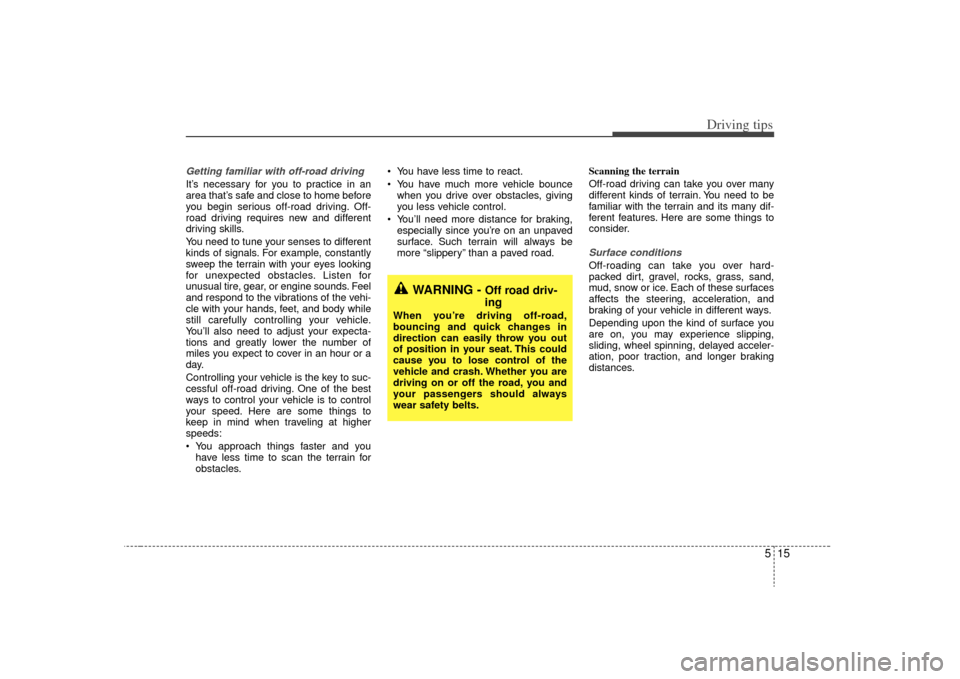
515
Driving tips
Getting familiar with off-road drivingIt’s necessary for you to practice in an
area that’s safe and close to home before
you begin serious off-road driving. Off-
road driving requires new and different
driving skills.
You need to tune your senses to different
kinds of signals. For example, constantly
sweep the terrain with your eyes looking
for unexpected obstacles. Listen for
unusual tire, gear, or engine sounds. Feel
and respond to the vibrations of the vehi-
cle with your hands, feet, and body while
still carefully controlling your vehicle.
You’ll also need to adjust your expecta-
tions and greatly lower the number of
miles you expect to cover in an hour or a
day.
Controlling your vehicle is the key to suc-
cessful off-road driving. One of the best
ways to control your vehicle is to control
your speed. Here are some things to
keep in mind when traveling at higher
speeds:
You approach things faster and youhave less time to scan the terrain for
obstacles. You have less time to react.
You have much more vehicle bounce
when you drive over obstacles, giving
you less vehicle control.
You’ll need more distance for braking, especially since you’re on an unpaved
surface. Such terrain will always be
more “slippery” than a paved road. Scanning the terrain
Off-road driving can take you over many
different kinds of terrain. You need to be
familiar with the terrain and its many dif-
ferent features. Here are some things to
consider.
Surface conditionsOff-roading can take you over hard-
packed dirt, gravel, rocks, grass, sand,
mud, snow or ice. Each of these surfaces
affects the steering, acceleration, and
braking of your vehicle in different ways.
Depending upon the kind of surface you
are on, you may experience slipping,
sliding, wheel spinning, delayed acceler-
ation, poor traction, and longer braking
distances.
WARNING -
Off road driv-
ing
When you’re driving off-road,
bouncing and quick changes in
direction can easily throw you out
of position in your seat. This could
cause you to lose control of the
vehicle and crash. Whether you are
driving on or off the road, you and
your passengers should always
wear safety belts.
Page 222 of 327
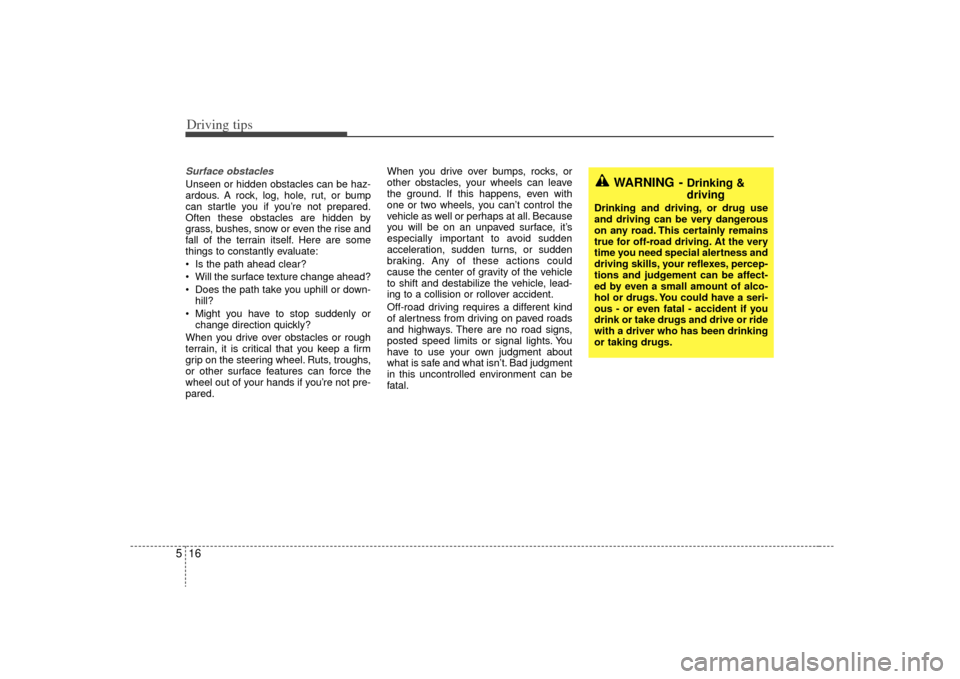
Driving tips16
5
WARNING -
Drinking &
driving
Drinking and driving, or drug use
and driving can be very dangerous
on any road. This certainly remains
true for off-road driving. At the very
time you need special alertness and
driving skills, your reflexes, percep-
tions and judgement can be affect-
ed by even a small amount of alco-
hol or drugs. You could have a seri-
ous - or even fatal - accident if you
drink or take drugs and drive or ride
with a driver who has been drinking
or taking drugs.
Surface obstaclesUnseen or hidden obstacles can be haz-
ardous. A rock, log, hole, rut, or bump
can startle you if you’re not prepared.
Often these obstacles are hidden by
grass, bushes, snow or even the rise and
fall of the terrain itself. Here are some
things to constantly evaluate:
Is the path ahead clear?
Will the surface texture change ahead?
Does the path take you uphill or down-
hill?
Might you have to stop suddenly or change direction quickly?
When you drive over obstacles or rough
terrain, it is critical that you keep a firm
grip on the steering wheel. Ruts, troughs,
or other surface features can force the
wheel out of your hands if you’re not pre-
pared. When you drive over bumps, rocks, or
other obstacles, your wheels can leave
the ground. If this happens, even with
one or two wheels, you can’t control the
vehicle as well or perhaps at all. Because
you will be on an unpaved surface, it’s
especially important to avoid sudden
acceleration, sudden turns, or sudden
braking. Any of these actions could
cause the center of gravity of the vehicle
to shift and destabilize the vehicle, lead-
ing to a collision or rollover accident.
Off-road driving requires a different kind
of alertness from driving on paved roads
and highways. There are no road signs,
posted speed limits or signal lights. You
have to use your own judgment about
what is safe and what isn’t. Bad judgment
in this uncontrolled environment can be
fatal.
Page 223 of 327
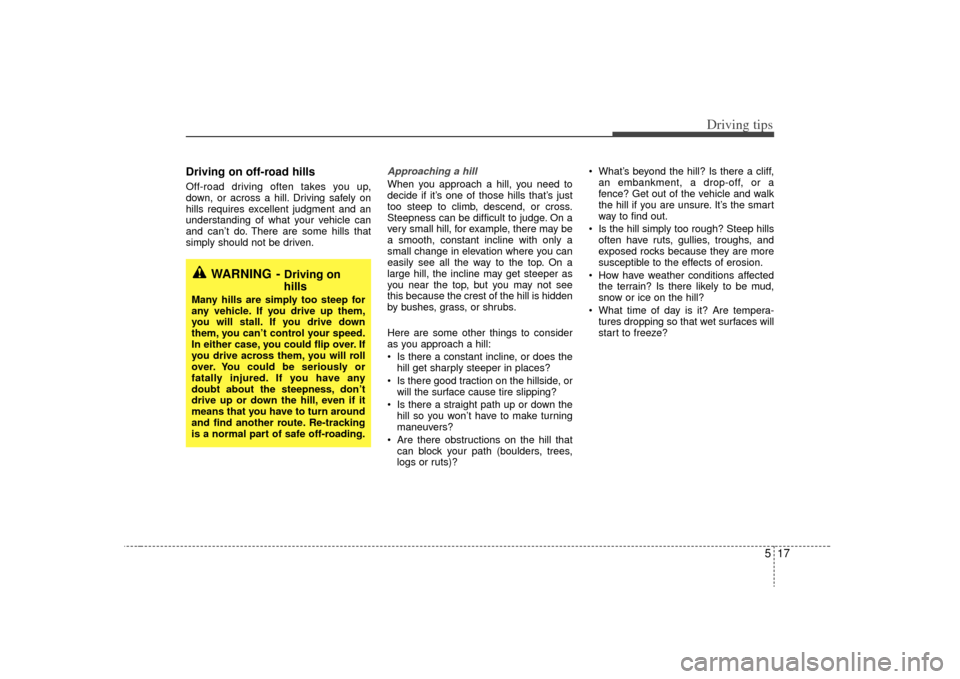
517
Driving tips
Driving on off-road hillsOff-road driving often takes you up,
down, or across a hill. Driving safely on
hills requires excellent judgment and an
understanding of what your vehicle can
and can’t do. There are some hills that
simply should not be driven.
Approaching a hillWhen you approach a hill, you need to
decide if it’s one of those hills that’s just
too steep to climb, descend, or cross.
Steepness can be difficult to judge. On a
very small hill, for example, there may be
a smooth, constant incline with only a
small change in elevation where you can
easily see all the way to the top. On a
large hill, the incline may get steeper as
you near the top, but you may not see
this because the crest of the hill is hidden
by bushes, grass, or shrubs.
Here are some other things to consider
as you approach a hill:
Is there a constant incline, or does thehill get sharply steeper in places?
Is there good traction on the hillside, or will the surface cause tire slipping?
Is there a straight path up or down the hill so you won’t have to make turning
maneuvers?
Are there obstructions on the hill that can block your path (boulders, trees,
logs or ruts)? What’s beyond the hill? Is there a cliff,
an embankment, a drop-off, or a
fence? Get out of the vehicle and walk
the hill if you are unsure. It’s the smart
way to find out.
Is the hill simply too rough? Steep hills often have ruts, gullies, troughs, and
exposed rocks because they are more
susceptible to the effects of erosion.
How have weather conditions affected the terrain? Is there likely to be mud,
snow or ice on the hill?
What time of day is it? Are tempera- tures dropping so that wet surfaces will
start to freeze?
WARNING -
Driving on
hills
Many hills are simply too steep for
any vehicle. If you drive up them,
you will stall. If you drive down
them, you can’t control your speed.
In either case, you could flip over. If
you drive across them, you will roll
over. You could be seriously or
fatally injured. If you have any
doubt about the steepness, don’t
drive up or down the hill, even if it
means that you have to turn around
and find another route. Re-tracking
is a normal part of safe off-roading.
Page 224 of 327
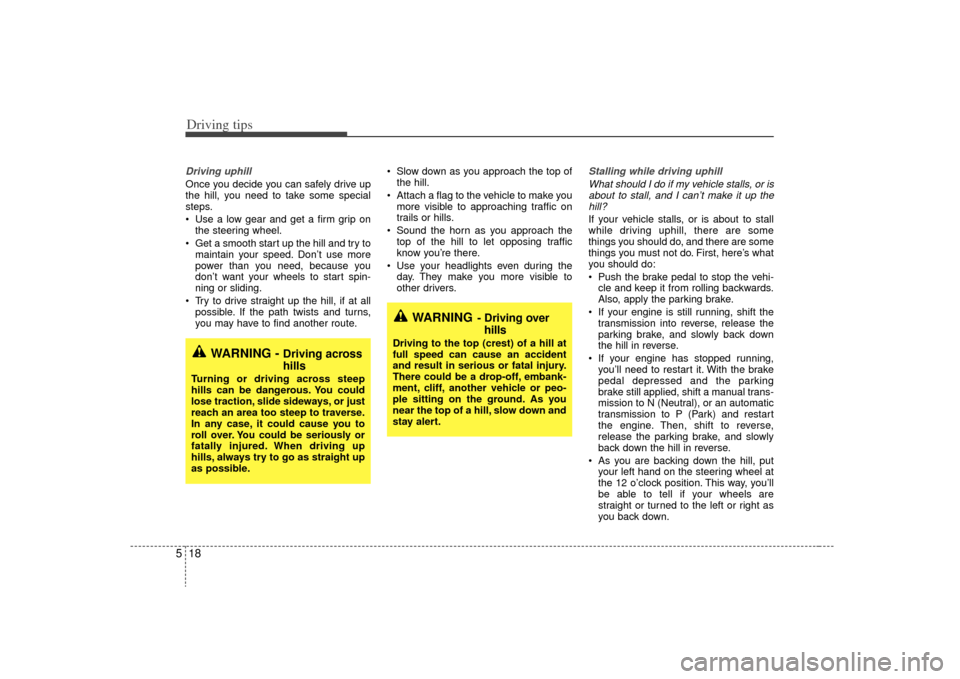
Driving tips18
5Driving uphillOnce you decide you can safely drive up
the hill, you need to take some special
steps.
Use a low gear and get a firm grip on
the steering wheel.
Get a smooth start up the hill and try to maintain your speed. Don’t use more
power than you need, because you
don’t want your wheels to start spin-
ning or sliding.
Try to drive straight up the hill, if at all possible. If the path twists and turns,
you may have to find another route. Slow down as you approach the top of
the hill.
Attach a flag to the vehicle to make you more visible to approaching traffic on
trails or hills.
Sound the horn as you approach the top of the hill to let opposing traffic
know you’re there.
Use your headlights even during the day. They make you more visible to
other drivers.
Stalling while driving uphill
What should I do if my vehicle stalls, or isabout to stall, and I can’t make it up thehill?If your vehicle stalls, or is about to stall
while driving uphill, there are some
things you should do, and there are some
things you must not do. First, here’s what
you should do:
Push the brake pedal to stop the vehi- cle and keep it from rolling backwards.
Also, apply the parking brake.
If your engine is still running, shift the transmission into reverse, release the
parking brake, and slowly back down
the hill in reverse.
If your engine has stopped running, you’ll need to restart it. With the brake
pedal depressed and the parking
brake still applied, shift a manual trans-
mission to N (Neutral), or an automatic
transmission to P (Park) and restart
the engine. Then, shift to reverse,
release the parking brake, and slowly
back down the hill in reverse.
As you are backing down the hill, put your left hand on the steering wheel at
the 12 o’clock position. This way, you’ll
be able to tell if your wheels are
straight or turned to the left or right as
you back down.
WARNING -
Driving across
hills
Turning or driving across steep
hills can be dangerous. You could
lose traction, slide sideways, or just
reach an area too steep to traverse.
In any case, it could cause you to
roll over. You could be seriously or
fatally injured. When driving up
hills, always try to go as straight up
as possible.
WARNING
- Driving overhills
Driving to the top (crest) of a hill at
full speed can cause an accident
and result in serious or fatal injury.
There could be a drop-off, embank-
ment, cliff, another vehicle or peo-
ple sitting on the ground. As you
near the top of a hill, slow down and
stay alert.
Page 225 of 327
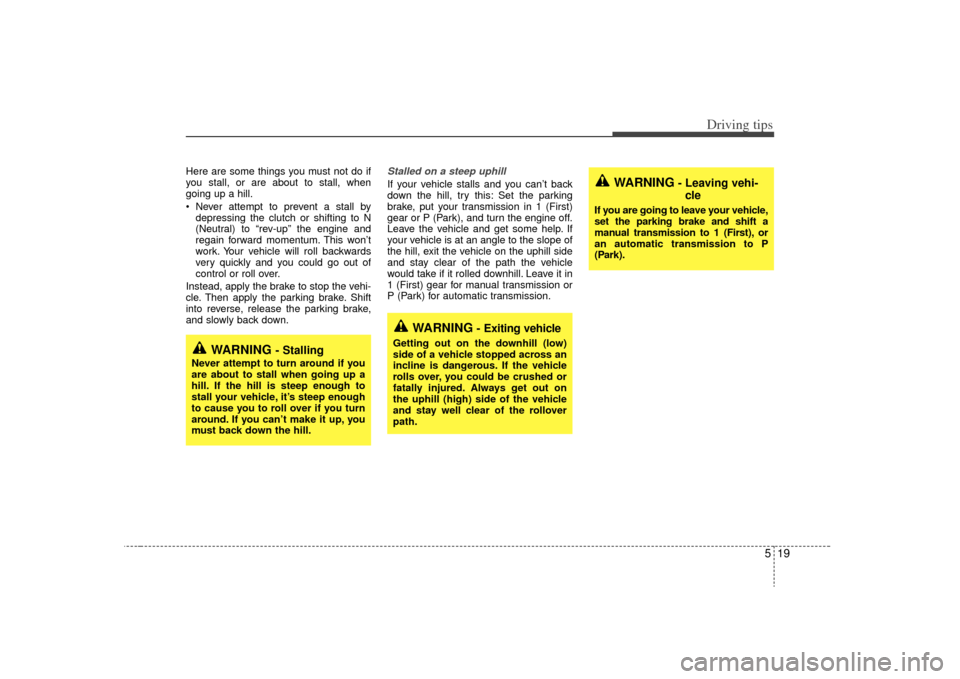
519
Driving tips
Here are some things you must not do if
you stall, or are about to stall, when
going up a hill.
Never attempt to prevent a stall bydepressing the clutch or shifting to N
(Neutral) to “rev-up” the engine and
regain forward momentum. This won’t
work. Your vehicle will roll backwards
very quickly and you could go out of
control or roll over.
Instead, apply the brake to stop the vehi-
cle. Then apply the parking brake. Shift
into reverse, release the parking brake,
and slowly back down.
Stalled on a steep uphillIf your vehicle stalls and you can’t back
down the hill, try this: Set the parking
brake, put your transmission in 1 (First)
gear or P (Park), and turn the engine off.
Leave the vehicle and get some help. If
your vehicle is at an angle to the slope of
the hill, exit the vehicle on the uphill side
and stay clear of the path the vehicle
would take if it rolled downhill. Leave it in
1 (First) gear for manual transmission or
P (Park) for automatic transmission.
WARNING
- Stalling
Never attempt to turn around if you
are about to stall when going up a
hill. If the hill is steep enough to
stall your vehicle, it’s steep enough
to cause you to roll over if you turn
around. If you can’t make it up, you
must back down the hill.
WARNING
- Exiting vehicle
Getting out on the downhill (low)
side of a vehicle stopped across an
incline is dangerous. If the vehicle
rolls over, you could be crushed or
fatally injured. Always get out on
the uphill (high) side of the vehicle
and stay well clear of the rollover
path.
WARNING
- Leaving vehi- cle
If you are going to leave your vehicle,
set the parking brake and shift a
manual transmission to 1 (First), or
an automatic transmission to P
(Park).
Page 226 of 327
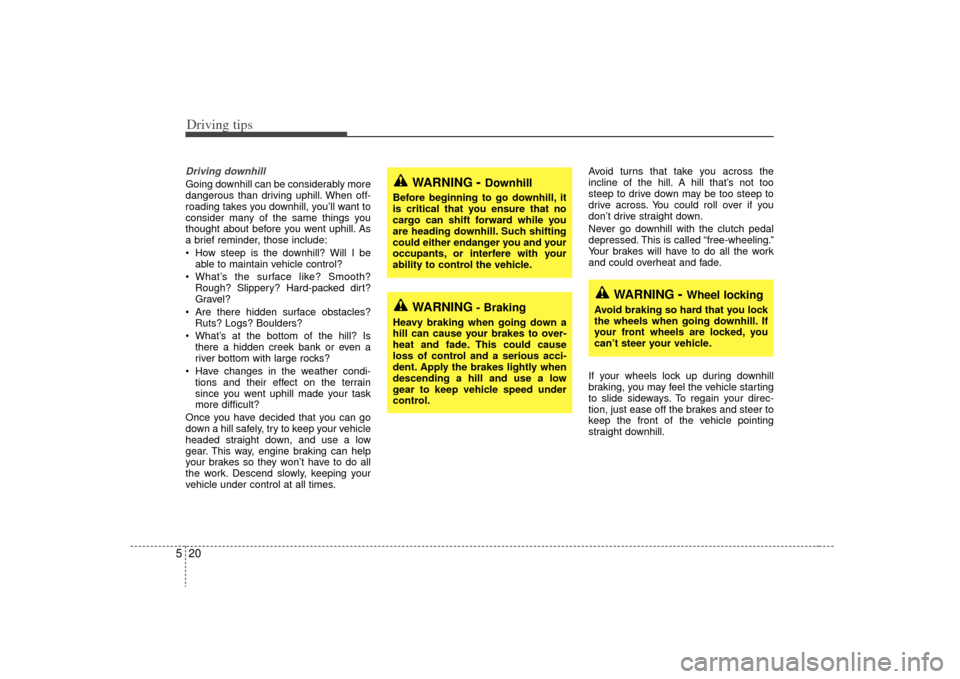
Driving tips20
5Driving downhillGoing downhill can be considerably more
dangerous than driving uphill. When off-
roading takes you downhill, you’ll want to
consider many of the same things you
thought about before you went uphill. As
a brief reminder, those include:
How steep is the downhill? Will I be
able to maintain vehicle control?
What’s the surface like? Smooth? Rough? Slippery? Hard-packed dirt?
Gravel?
Are there hidden surface obstacles? Ruts? Logs? Boulders?
What’s at the bottom of the hill? Is there a hidden creek bank or even a
river bottom with large rocks?
Have changes in the weather condi- tions and their effect on the terrain
since you went uphill made your task
more difficult?
Once you have decided that you can go
down a hill safely, try to keep your vehicle
headed straight down, and use a low
gear. This way, engine braking can help
your brakes so they won’t have to do all
the work. Descend slowly, keeping your
vehicle under control at all times. Avoid turns that take you across the
incline of the hill. A hill that’s not too
steep to drive down may be too steep to
drive across. You could roll over if you
don’t drive straight down.
Never go downhill with the clutch pedal
depressed. This is called “free-wheeling.”
Your brakes will have to do all the work
and could overheat and fade.
If your wheels lock up during downhill
braking, you may feel the vehicle starting
to slide sideways. To regain your direc-
tion, just ease off the brakes and steer to
keep the front of the vehicle pointing
straight downhill.
WARNING
- Braking
Heavy braking when going down a
hill can cause your brakes to over-
heat and fade. This could cause
loss of control and a serious acci-
dent. Apply the brakes lightly when
descending a hill and use a low
gear to keep vehicle speed under
control.
WARNING
- Wheel locking
Avoid braking so hard that you lock
the wheels when going downhill. If
your front wheels are locked, you
can’t steer your vehicle.
WARNING
- Downhill
Before beginning to go downhill, it
is critical that you ensure that no
cargo can shift forward while you
are heading downhill. Such shifting
could either endanger you and your
occupants, or interfere with your
ability to control the vehicle.
Page 227 of 327
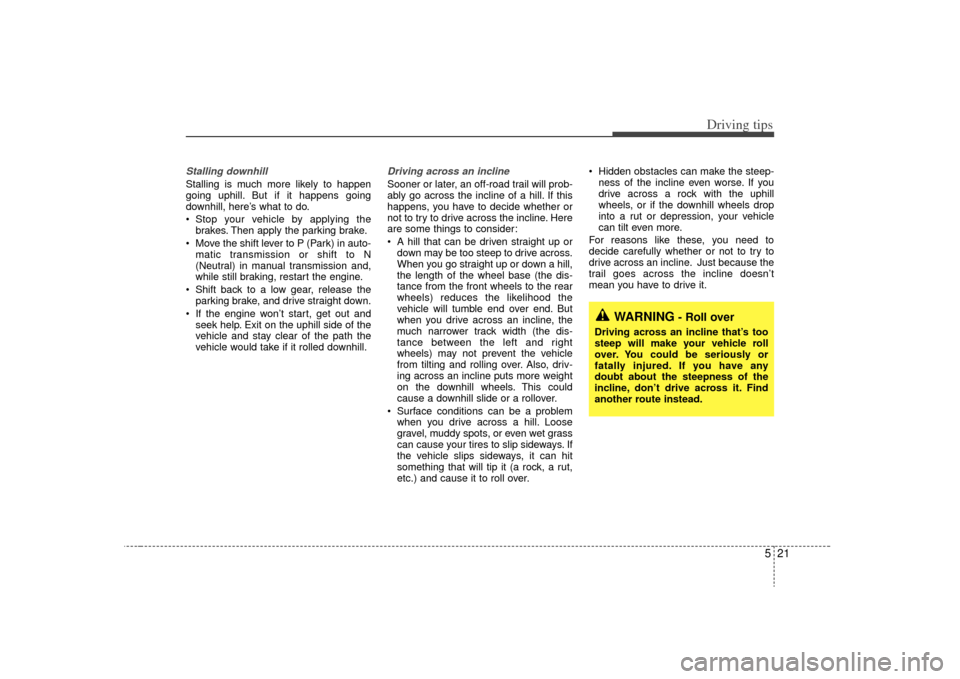
521
Driving tips
Stalling downhillStalling is much more likely to happen
going uphill. But if it happens going
downhill, here’s what to do.
Stop your vehicle by applying thebrakes. Then apply the parking brake.
Move the shift lever to P (Park) in auto- matic transmission or shift to N
(Neutral) in manual transmission and,
while still braking, restart the engine.
Shift back to a low gear, release the parking brake, and drive straight down.
If the engine won’t start, get out and seek help. Exit on the uphill side of the
vehicle and stay clear of the path the
vehicle would take if it rolled downhill.
Driving across an inclineSooner or later, an off-road trail will prob-
ably go across the incline of a hill. If this
happens, you have to decide whether or
not to try to drive across the incline. Here
are some things to consider:
A hill that can be driven straight up ordown may be too steep to drive across.
When you go straight up or down a hill,
the length of the wheel base (the dis-
tance from the front wheels to the rear
wheels) reduces the likelihood the
vehicle will tumble end over end. But
when you drive across an incline, the
much narrower track width (the dis-
tance between the left and right
wheels) may not prevent the vehicle
from tilting and rolling over. Also, driv-
ing across an incline puts more weight
on the downhill wheels. This could
cause a downhill slide or a rollover.
Surface conditions can be a problem when you drive across a hill. Loose
gravel, muddy spots, or even wet grass
can cause your tires to slip sideways. If
the vehicle slips sideways, it can hit
something that will tip it (a rock, a rut,
etc.) and cause it to roll over. Hidden obstacles can make the steep-
ness of the incline even worse. If you
drive across a rock with the uphill
wheels, or if the downhill wheels drop
into a rut or depression, your vehicle
can tilt even more.
For reasons like these, you need to
decide carefully whether or not to try to
drive across an incline. Just because the
trail goes across the incline doesn’t
mean you have to drive it.
WARNING
- Roll over
Driving across an incline that’s too
steep will make your vehicle roll
over. You could be seriously or
fatally injured. If you have any
doubt about the steepness of the
incline, don’t drive across it. Find
another route instead.
Page 228 of 327
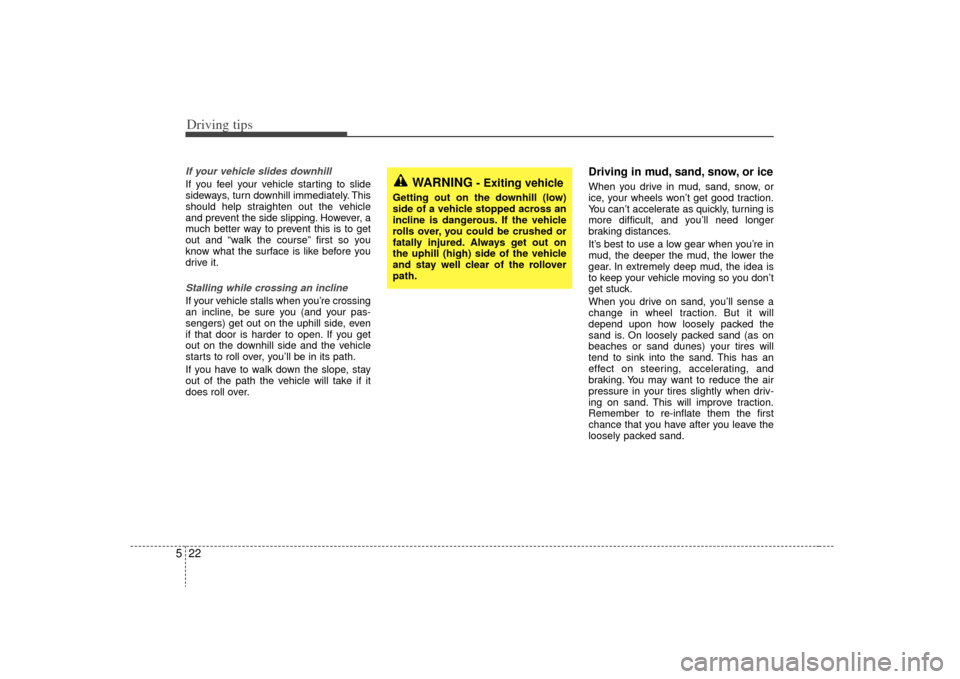
Driving tips22
5If your vehicle slides downhillIf you feel your vehicle starting to slide
sideways, turn downhill immediately. This
should help straighten out the vehicle
and prevent the side slipping. However, a
much better way to prevent this is to get
out and “walk the course” first so you
know what the surface is like before you
drive it.Stalling while crossing an inclineIf your vehicle stalls when you’re crossing
an incline, be sure you (and your pas-
sengers) get out on the uphill side, even
if that door is harder to open. If you get
out on the downhill side and the vehicle
starts to roll over, you’ll be in its path.
If you have to walk down the slope, stay
out of the path the vehicle will take if it
does roll over.
Driving in mud, sand, snow, or iceWhen you drive in mud, sand, snow, or
ice, your wheels won’t get good traction.
You can’t accelerate as quickly, turning is
more difficult, and you’ll need longer
braking distances.
It’s best to use a low gear when you’re in
mud, the deeper the mud, the lower the
gear. In extremely deep mud, the idea is
to keep your vehicle moving so you don’t
get stuck.
When you drive on sand, you’ll sense a
change in wheel traction. But it will
depend upon how loosely packed the
sand is. On loosely packed sand (as on
beaches or sand dunes) your tires will
tend to sink into the sand. This has an
effect on steering, accelerating, and
braking. You may want to reduce the air
pressure in your tires slightly when driv-
ing on sand. This will improve traction.
Remember to re-inflate them the first
chance that you have after you leave the
loosely packed sand.
WARNING
- Exiting vehicle
Getting out on the downhill (low)
side of a vehicle stopped across an
incline is dangerous. If the vehicle
rolls over, you could be crushed or
fatally injured. Always get out on
the uphill (high) side of the vehicle
and stay well clear of the rollover
path.
Page 229 of 327
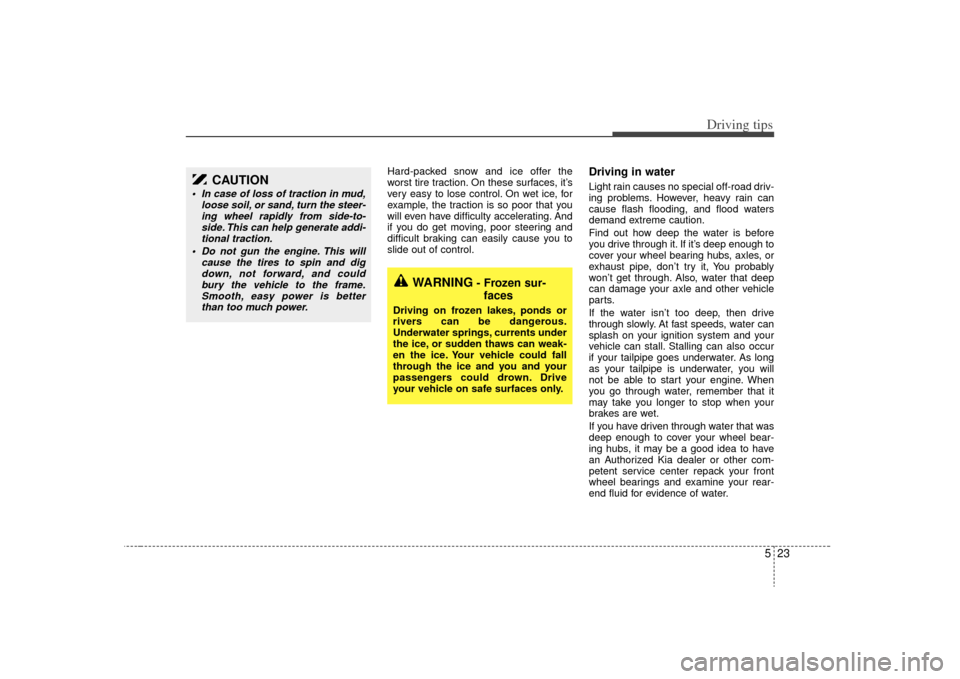
523
Driving tips
Hard-packed snow and ice offer the
worst tire traction. On these surfaces, it’s
very easy to lose control. On wet ice, for
example, the traction is so poor that you
will even have difficulty accelerating. And
if you do get moving, poor steering and
difficult braking can easily cause you to
slide out of control.
Driving in waterLight rain causes no special off-road driv-
ing problems. However, heavy rain can
cause flash flooding, and flood waters
demand extreme caution.
Find out how deep the water is before
you drive through it. If it’s deep enough to
cover your wheel bearing hubs, axles, or
exhaust pipe, don’t try it, You probably
won’t get through. Also, water that deep
can damage your axle and other vehicle
parts.
If the water isn’t too deep, then drive
through slowly. At fast speeds, water can
splash on your ignition system and your
vehicle can stall. Stalling can also occur
if your tailpipe goes underwater. As long
as your tailpipe is underwater, you will
not be able to start your engine. When
you go through water, remember that it
may take you longer to stop when your
brakes are wet.
If you have driven through water that was
deep enough to cover your wheel bear-
ing hubs, it may be a good idea to have
an Authorized Kia dealer or other com-
petent service center repack your front
wheel bearings and examine your rear-
end fluid for evidence of water.
CAUTION
In case of loss of traction in mud,loose soil, or sand, turn the steer-ing wheel rapidly from side-to-side. This can help generate addi- tional traction.
Do not gun the engine. This will cause the tires to spin and digdown, not forward, and couldbury the vehicle to the frame. Smooth, easy power is betterthan too much power.
WARNING
- Frozen sur-
faces
Driving on frozen lakes, ponds or
rivers can be dangerous.
Underwater springs, currents under
the ice, or sudden thaws can weak-
en the ice. Your vehicle could fall
through the ice and you and your
passengers could drown. Drive
your vehicle on safe surfaces only.
Page 230 of 327
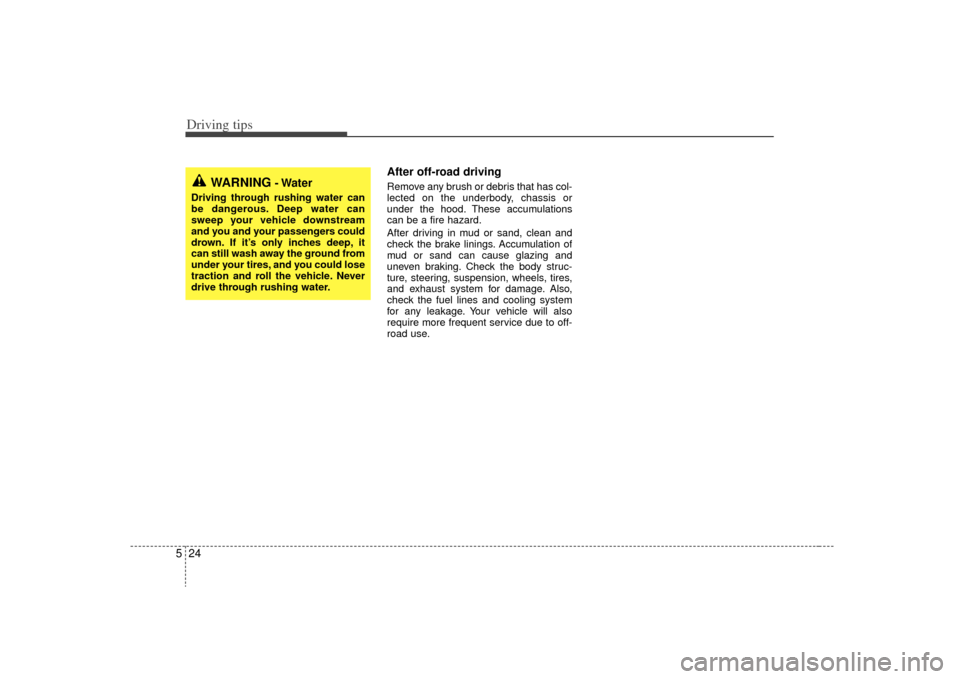
Driving tips24
5
After off-road drivingRemove any brush or debris that has col-
lected on the underbody, chassis or
under the hood. These accumulations
can be a fire hazard.
After driving in mud or sand, clean and
check the brake linings. Accumulation of
mud or sand can cause glazing and
uneven braking. Check the body struc-
ture, steering, suspension, wheels, tires,
and exhaust system for damage. Also,
check the fuel lines and cooling system
for any leakage. Your vehicle will also
require more frequent service due to off-
road use.
WARNING
- Water
Driving through rushing water can
be dangerous. Deep water can
sweep your vehicle downstream
and you and your passengers could
drown. If it’s only inches deep, it
can still wash away the ground from
under your tires, and you could lose
traction and roll the vehicle. Never
drive through rushing water.